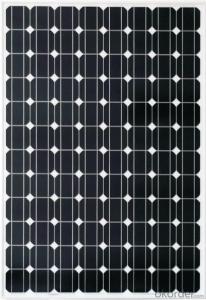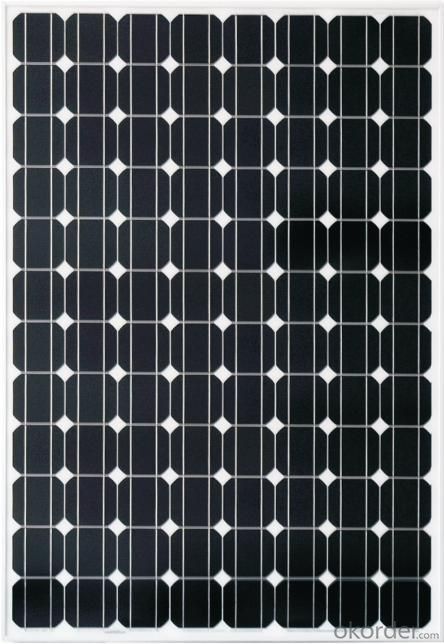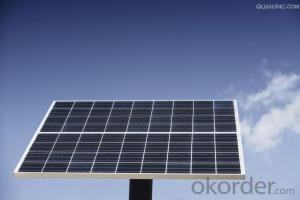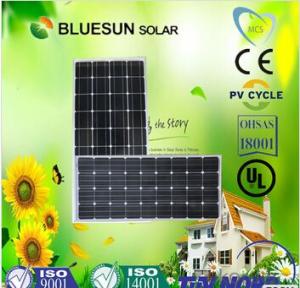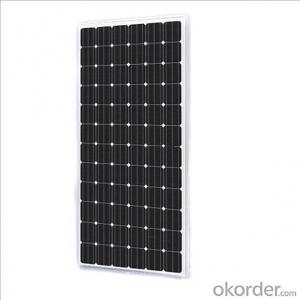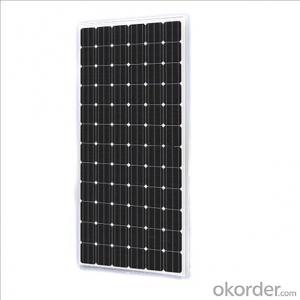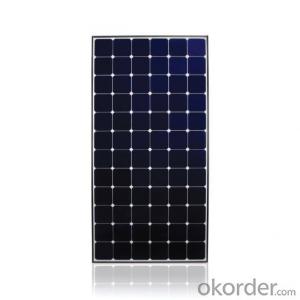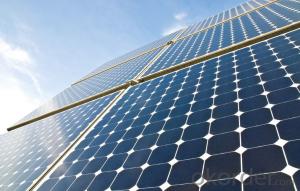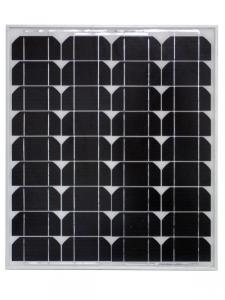Solar Panels for Sale in Houston - Monocrystalline Solar Module 270w
- Loading Port:
- China Main Port
- Payment Terms:
- TT OR LC
- Min Order Qty:
- -
- Supply Capability:
- -
OKorder Service Pledge
OKorder Financial Service
You Might Also Like
Solar Monocrystalline (210W-225W)
Introduction of Solar Monocrystalline (210W-225W)
Solar modules use light energy (photons) from the sun to generate electricity through the photovoltaic effect. The majority of modules use wafer-based crystalline silicon cells or thin-film cells based on cadmium telluride or silicon. The structural (load carrying) member of a module can either be the top layer or the back layer. Cells must also be protected from mechanical damage and moisture. Most solar modules are rigid, but semi-flexible ones are available, based on thin-film cells. These early solar modules were first used in space in 1958.
CNBM Solar photovoltaic (PV) Panel is designed for large electrical power requirements. It is the optimal choice for both on-grid and off-grid power systems. CNBM Solar panel offers high performance of power per square foot of solar array. Monocrystalline silicon(c-Si): often made using the Czochralski process. Single-crystal wafer cells tend to be expensive, and because they are cut from cylindrical ingots, do not completely cover a square solar cell module without a substantial waste of refined silicon. Hence most c-Si panels have uncovered gaps at the four corners of the cells.
Characteristics of Solar Monocrystalline (210W-225W)
I. Solar Cell : High efficiency crystalline solar cell. Even if under the weak light, the solar module can produce maximum power output.
II. Tempered glass (toughened glass): Anti-reflecting coating and high transmission rate glass increase the power output and mechanical strength of solar module.
III. EVA and TPT: Using high quality EVA and TPT to prevent destroying and water.
IV. AI frame: Without screw, corner connection. 6 holes on the frame can be installed easily.
V. Junction box: Multi function junction box with water proof.
VI. Long lifetime: ≥25 years; Less power decrease.
VII. Good performance of preventing from atrocious weather such as wind and hails.
VIII. Resisting moisture and etching effectively, not effected by geology.
IX. The certificate issued by international authority: UL, TUV, IEC, VDE, CE.
Standard Test Conditions of Solar Monocrystalline (210W-225W)
The opto-electrical specifications shown below are stabilized values being measured at Standard Test Conditions, Irradiance: 1000W/m2, Spectrum: AM1.5 at 25°C, The info below is subject to manufacturing tolerances. Where appropriate minutes of measurement are available and are used for the dimensioning of the installation.
Advantages of Solar Monocrystalline (210W-225W)
• CNBM Solar performance guarantees for 25 years
• 10 years guarantee for workmanship
• Timeliness of delivery
• Quality Products certified (TÜV, UL, CE, VDE, ISO)
CNBM International Corporation's products including Monocrystalline Solar Panel, Polycrystalline Solar Panel have received and enjoyed famous reputation in many countries and regions in the world .As a solar panel manufacturer in China, we strive to provide our customers with excellent service, superior products and unmatched value.
- Q: Can solar panels be installed on a boat?
- Yes, solar panels can be installed on a boat.
- Q: Single crystal solar panels and polycrystalline solar panels
- Monocrystalline silicon solar cells are mainly made of monocrystalline silicon, compared with other types of solar cells, monocrystalline silicon cell conversion efficiency of the highest. In the early days, monocrystalline silicon solar cells occupied most of the market share, in 1998 after the retreat of polysilicon, the market share accounted for second. Due to the shortage of polysilicon raw materials in recent years, after 2004,
- Q: I am trying to built a circuit that will power two USB ports (both 5V and 0.5 amps) from the output of a solar panel that produces 20V at 0.2 amps. I have a voltage regulator that runs at 5v and 0.5 amps but I can't figure out the best way to boost the current up to 0.5 amps before I incorporate the voltage regulators.
- If you want to power both USB ports at the same times, It might not be possibble. Your solar panel only supplies 2.24 Watts (20V * 0.2A) of power and you need to deliver 2.5 Watts (5V * 0.5A) to the ports. Subtracting any losses from your regulator(s), you will be WAY over your power budget. You will need more of a solar panel or less of a load.
- Q: i have a small solar panel,the ones from a garden lamp that turns on at night-i think.what i was wondering is can i just connect the solar panel to a capacitor and then a light just to test?or do i need something to convert the solar energy to usable energy?and how do i tell if a capacitor is broken?
- solar panels for those lights provide the power directly to the light, so there is no capacitor used or needed. in any event, capacitors very rarely break but you would need an OHM meter to test it.
- Q: Solar panel packages have different levels of power. For instance you can get a kw system but is this kw per hour or day. How does this work?
- That means if you stick a watt meter on the output when there is maximum design sunlight on it you will get kw. If you shine the maximum design sunlight on it for hour then you get kw hour of power. In one day you get 24kw hours assuming you can get 24 hours of maximum design sunlight. Your home electric bill is typically in kw hours. At the macro level power is traded at megawatt hours.
- Q: Can solar panels be used in areas with high levels of pollution from industrial activities?
- Yes, solar panels can be used in areas with high levels of pollution from industrial activities. While pollution can have some impact on the efficiency of solar panels, they are still able to generate electricity even in polluted areas. Regular cleaning and maintenance of the panels may be required to ensure optimal performance. Additionally, installing solar panels in such areas can help offset some of the carbon emissions from industrial activities, contributing to a cleaner and more sustainable energy future.
- Q: 3.8 volts is required to fully charge a battery. But at 3.8 volts, the battery can be overcharged without the use of a controller correct? What if I don't care if the battery is fully charged? In the case of our family boat, I just installed a new radio, so I'm a little worried about power consumption. So now for the real question; If I hook a 2 volt panel to the batteries, do I need to worry about overcharging them? Or will the batteries stop the charging process once they reach 2 volt?I built the panel myself, it's 8 volts at 3.5 amps open circuit. I have tabs at every 3 volt increment on the panel so that I can use less voltage than 8 if I want to power something directly, (ex:2 volt radio)So I'm using the 2 volt tab at 3.5 amps(approx) for a total of approx 48 watts
- Batteries will not stop charging on their own. The will stop charging when the battery voltage equals the supply voltage. Solar panel open circuit voltage is typically around 20V. Batteries will just boil dry before reaching 20V. One rule of thumb, above 0W you need a controller for sure.
- Q: We see increasing, what appear to be, solar panels on electric poles?
- Usually they are used to power monitoring units that transmit data to a central point on usage and/or line loads. They may also be used to supply power to some control circuits, and to allow remote control of these units. (If there was no power in the line, how else could you supply the needed power to obtain information and/or control these things remotely.) What they do is keep a standby or backup battery charged to operate the equipment. They are also used for self-powered lights in many areas, charging batteries during the day to run the light(s) at night. Similar systems are used on monitoring wells to transmit water table data. (Faster, cheaper, and more timely than sending someone around to make checks and read equipment once every couple of months.)
- Q: Can solar panels be installed on remote monitoring systems?
- Yes, solar panels can be installed on remote monitoring systems. Solar panels are a sustainable and reliable source of energy that can power remote monitoring systems, allowing them to operate independently from the electrical grid. This makes solar panels a suitable and practical solution for remote locations where access to electricity may be limited.
- Q: Can solar panels be damaged by hail or other flying debris?
- Yes, solar panels can be damaged by hail or other flying debris. Hailstones, in particular, can cause cracks, dents, or even punctures on the surface of solar panels, reducing their efficiency or functionality. To mitigate the risk of damage, many solar panels are designed to withstand certain levels of impact and are typically tested for durability. Additionally, some solar panel installations utilize protective measures, such as tempered glass or anti-hail nets, to minimize potential damage caused by hail or flying debris.
Send your message to us
Solar Panels for Sale in Houston - Monocrystalline Solar Module 270w
- Loading Port:
- China Main Port
- Payment Terms:
- TT OR LC
- Min Order Qty:
- -
- Supply Capability:
- -
OKorder Service Pledge
OKorder Financial Service
Similar products
Hot products
Hot Searches
Related keywords
